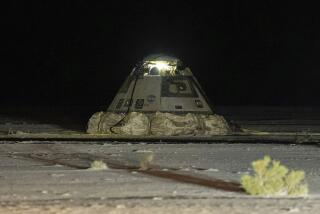High Winds Delay Shuttle’s Return for Second Day
- Share via
CAPE CANAVERAL, Fla. — For the second day in a row, gusts of nearly 25 mph forced space shuttle Atlantis and its astronauts to keep circling Earth on Monday instead of coming home.
The weather was no better at the backup landing site in Southern California, so Mission Control ordered the crew to spend a 13th day in orbit and aim for a touchdown this afternoon.
“Bottom line is we’re waving off,” Mission Control told commander Kenneth Cockrell. “We do have three sites for [today], all of them have a ‘go’ forecast at this time.”
Atlantis and its crew of five undocked from the international space station Friday, after delivering and installing the $1.4-billion Destiny laboratory, and should have returned to Earth on Sunday.
But the crosswind at the Florida landing strip was well above the 17-mph safety limit, a situation that recurred Monday. Not only that, thick clouds began moving in Monday and NASA worried they might bring rain.
The last time Cockrell flew in space, the mission dragged on for almost 18 days because of landing delays and turned out to be the longest shuttle flight ever. Atlantis astronaut Thomas Jones was also on that 1996 mission.
“The rest of the crew wanted me to pass on that I already have the endurance record,” Cockrell joked to Mission Control as the weather deteriorated. “So there’s no need to try for that this time.”
Mission Control replied: “We’ll do our best to get you back as well before you exceed that 18-day record you’ve already set.”
Meteorologists expected good weather, finally, at the Kennedy Space Center today. The other two options were Edwards Air Force Base in California and White Sands, N.M., as a last resort. A space shuttle has landed only once at White Sands, back in 1982.
Flight director Leroy Cain said he would not consider White Sands “unless it was the only place that we were able to land in the endgame.”
Atlantis and its astronauts have enough fuel, water, air purifiers and other supplies to remain aloft until Wednesday, Cain said.
“The weather is a very tricky thing to deal with, it’s not an exact science,” Cain said. But he promised: “We’ll find a landing site [today] where we’re confident that we can perform a safe landing.”
Until all the landing delays, the mission had gone off without a hitch to the pleasant surprise of both the astronauts and ground controllers.
The spectacular sunset launch on Feb. 7 was followed by a flawless linkup with the space station two days later and the eventual installation of the Destiny laboratory.
It took three spacewalks and the assistance of the both the shuttle and station crews to install the lab module.
More to Read
Sign up for Essential California
The most important California stories and recommendations in your inbox every morning.
You may occasionally receive promotional content from the Los Angeles Times.










